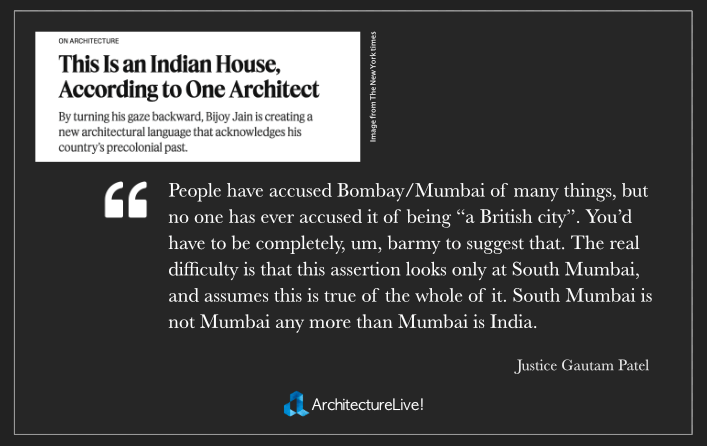The social media feeds of architects are flooded with the recent article in The New York Times by Aatish Taseer on Bijoy Jain. While it is mostly being shared on social media with a sense of pride, there are some disagreements too. We came across Justice Gautam Patel’s reaction to the article, which he sent to a small group of architects. Justice Gautam Patel clarified that his response is about the way article is written and not Bijoy Jain’s work.
The contents of his email are published below:
While it’s always good to see one of our own in an international newspaper, there is much to question and doubt in this writing.
For instance, I have the greatest difficulty with this statement:
“The meeting of Britain and India did not produce an enduring synthesis. When the British left, India’s own building traditions were paralyzed. What took their place was the seeming cultural neutrality of what was then called the International Style — modernity, in a word — which produced an awful proliferation of nondescript residential colonies on the edges of crumbling British cities, which, in turn, abutted medieval Indo-Islamic cities, swiftly turning to slums. The challenge then, for any architect working in India today, is how to break past the layer of nonporous rock that is British rule in India in order to creatively engage with a decayed but living tradition of Indian building, masonry and craftsmanship.”
No, slums and “nondescript residential colonies” are not all that post-Independent India’s architecture produced. This kind of sweeping generalization is unfair and unjust to so many.
Then there’s this:
“What did Jain, who believes so much in making one’s peace with one’s surroundings, think of the British city directly behind him? “It is just a backdrop,” Jain said, adding of the Gateway itself: “It’s a terribly proportioned building. They should take it down. It would open the city to the sea.” He said this without a trace of a smile as our little boat charted a foamy path across the harbor.”
People have accused Bombay/Mumbai of many things, but no one has ever accused it of being “a British city”. You’d have to be completely, um, barmy to suggest that. The real difficulty is that this assertion looks only at South Mumbai, and assumes this is true of the whole of it. South Mumbai is not Mumbai any more than Mumbai is India.
Justice Gautam Patel
And as for the Gateway, well, it is what it is, and what it is is part of us, so let’s just get on with it. If you’re going to advocate demolition on the basis of a perceived individualistic notion of aesthetics, then it’s fair to say there are any number of old things that should go: the Qutb Minar because it is so incredibly ugly; the Charminar because it has such terrible proportions; and the Taj with its minarets becuase it is all out of whack (as compared to, say, Itmad-ud-Daulah nearby).
In this day and age, advocating demolition of this or that older structure comes with a barrel of dangers.
This is, of course, no comment at all on Jain’s work; I just don’t think very much of the piece. It’s definitely more than a little OTT. It’s long on opinion, short on meaningful analysis and I do believe that overall it does Bijoy Jain a singular disservice by positioning him in too absolute terms.









